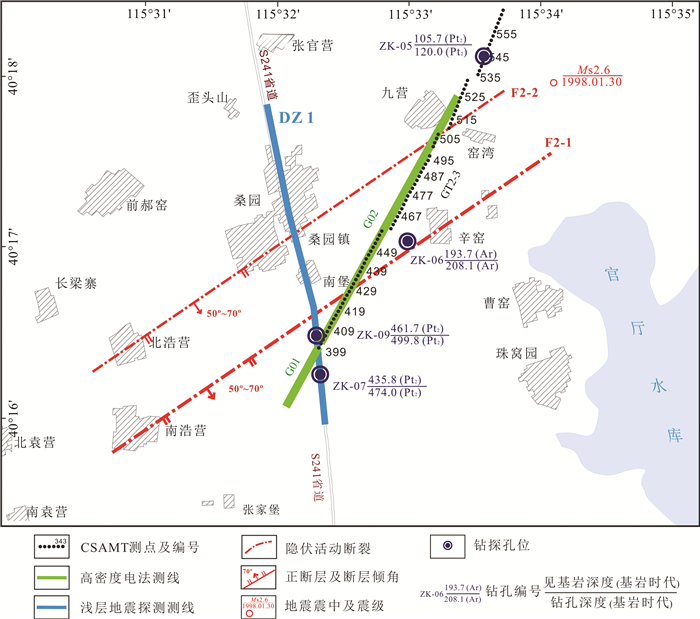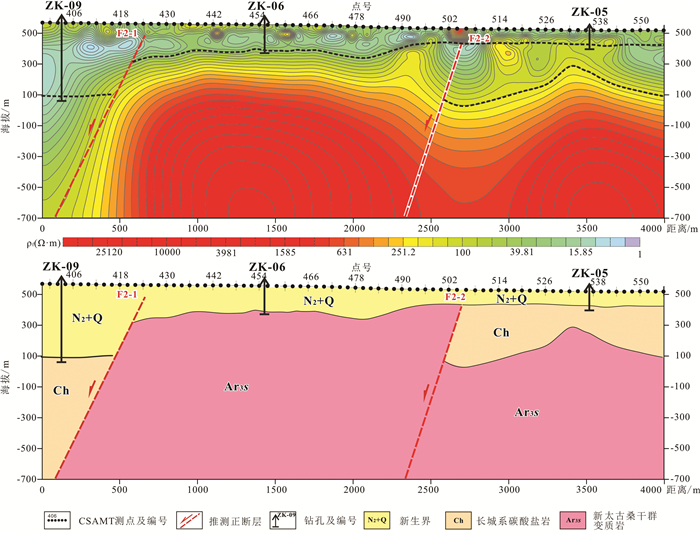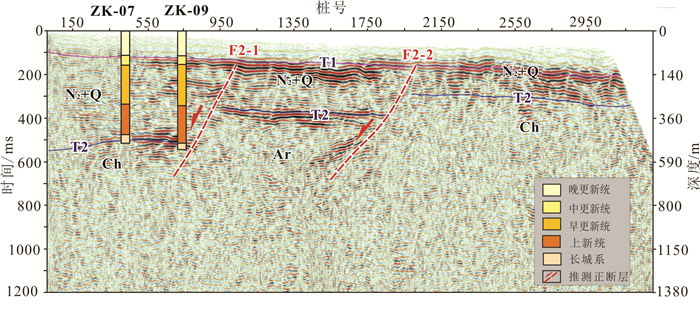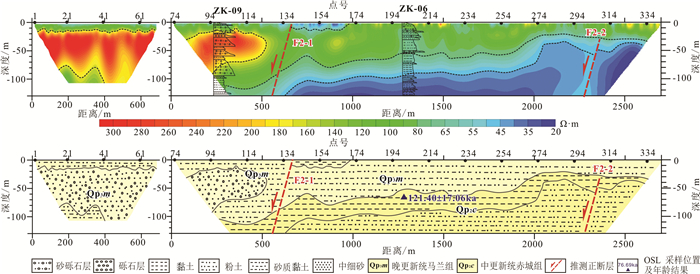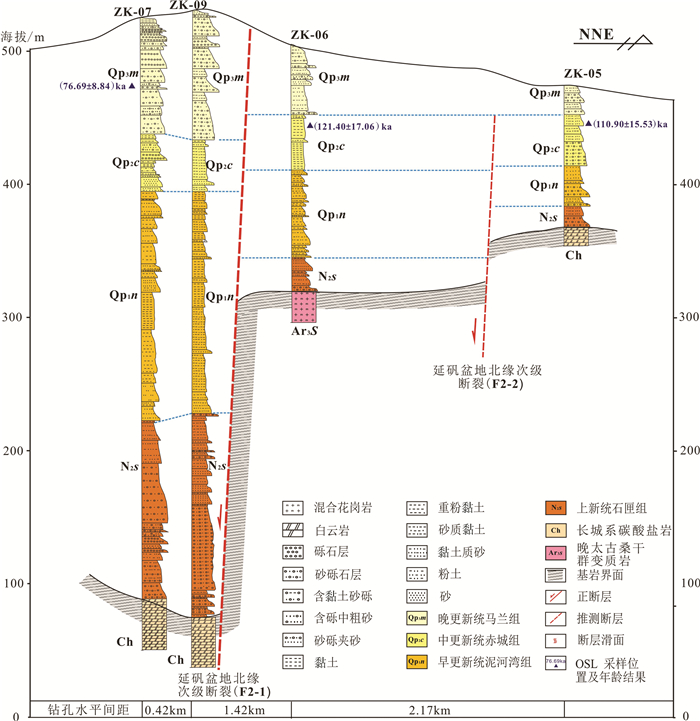Application of comprehensive geophysical-drilling exploration to detect the buried North Boundary active Fault Belt of Yanqing-Fanshan Basin in Sangyuan town, Beijing-Zhangjiakou area
-
摘要:
京张高铁预选路线跨越延矾盆地北缘活动断裂隐伏段,隐伏活动断裂的产状、活动性对高铁设计、建设和运营具有直接影响。针对盆地隐伏活动断裂的复杂性特征,利用可控源音频大地电磁测深(CSAMT)、浅层地震、高密度电阻率综合地球物理探测,以及钻孔地层剖面记录等方法,分析延矾盆地北缘活动断裂隐伏段特征,结果表明:(1)延矾盆地北缘活动断裂隐伏段由两条次级断层组成(F2-1、F2-2),二者大致平行分布,走向N56°E,倾角为50~70°,平面上,与地表出露段共同呈右阶雁列分布;(2)F2-1次级断层可分辨上断点埋深约10 m,其晚更新世以来垂直滑动速率大约0.12 mm/a,应是重大工程建设重点设防对象,次级断裂F2-2可分辨上断点埋深约30 m,晚更新世以来活动性弱;(3)通过钻孔地层剖面记录与地球物理探测成果对比,CSAMT法与浅层地震勘探对基岩顶界面探测可靠有效,高密度电阻率法对于该地区浅部第四系松散堆积物探测效果显著,比较直观地反映出电性异常体的形态和规模,通过综合地球物理探测,能够做到优势互补,减少隐伏活动断层解译的不确定性。
Abstract:North Yanqing and Fanshan Basin active fault is a significant factor for engineering design of Beijing-Zhangjiakou highspeed railway, and buried section of this active fault in Yanqing and Fanshan Basin is complicated and unclear. In order to detect the location, characteristics and activity intensity of the buried active fault, the authors used many methods, such as the controlled source audio-frequency magnetotelluric (CSAMT), shallow seismic reflection, high density resistivity and drilling exploration. The results show that the buried North Yanqing and Fanshan Basin active fault consists of two secondary faults, i.e., F2-1, F2-2, which are distributed parallelly. The trending of the tow secondary faults is N56°E, and the dip angle of them is 50~70°. Meanwhile, they are right-stepped, oblique-arranged normal faults. The burial depth of distinguishable broken point is 10m for F2-1 secondary fault and 30m for F2-2 secondary fault. F2-1 secondary fault is an active fault, its vertical activity rate has been 0.12mm/a since the Late Pleistocene. Activity of F2-2 secondary fault has been weak since the Late Pleistocene. Compared with the result of drilling exploration, the CSAMT method and shallow seismic reflection method have some advantages in exploration of bedrock interface, whereas the high density resistivity method is good at exploration of shallow loose deposits and can display more effectively broken point of fault. By means of comprehensive geophysical-drilling exploration, researchers can achieve the complementary advantages, and can reduce the uncertainty of the interpretation for buried active faults exploration.
-
致谢: 中国地质科学院地质力学研究所王苗苗博士、牛琳琳博士,中国地质大学(北京)任思起硕士、范玉璐硕士等参与野外调查、选线工作;地球物理探测与解译由北京市地质勘察技术院李晨高级工程师、关伟高级工程师等协助完成;钻孔岩心编录由江苏省地质调查研究院宗开红教授指导完成;光释光年龄测试由中国地震局地壳应力研究所(地壳动力学重点实验室)赵俊香高工协助完成,谨表感谢。
-
表 1 OSL年龄测试结果
Table 1 OSL dating parameters and test results of samples

-
Cao Xianzhi, Li Sanzhong, Liu Xin, Suo Yanhui, Zhao Shujuan, Xu Liqing, Dai Liming, Wang Pengcheng, Yu Shan. 2013. The intraplate morphotectonic inversion along the Eastern Taihang Mountain Fault Zone, North China and its mechanism[J]. Earth Science Frontiers, 20(4):88-103(in Chinese with English abstract). http://d.old.wanfangdata.com.cn/Periodical/dxqy201304007
Chen Jiansheng, Zhang Faming, Yang Liang, Zhao weibing. 1999. Research on the comprehensive tracer method for surveying seepasge of dam embankment by pass in rock stratum of reservoir[J]. Geotechnical Investigation and Surveying, 1:34-38(in Chinese with English abstract). http://www.wanfangdata.com.cn/details/detail.do?_type=perio&id=gckc199901011
Cheng Shaoping, Fang Zhongjing. 1995. On segmentation of the fault zone along the northern margin of yanqing basin and earthquade parediction[J]. Seismology and Geology, 17(3):231-240(in Chinese with English abstract).
Cheng Shaoping, Yang Guizhi, Yang Zhe. 1994. The latest Pleistocene faulting along the canfangying segment of the fault zone alone the northern margin of Yanqing Basin[J]. Seismology and Geology, 16(4):346-354(in Chinese with English abstract). http://en.cnki.com.cn/Article_en/CJFDTotal-DZDZ404.008.htm
Deng Qidong, Xu Xiwei, Zhang Xiankang, Wang Guangcai. 2003.Methods and techniques for surveying and prospecting active faults in urban areas[J]. Earth Science Frontiers, 10(1):93-104(in Chinese with English abstract). http://www.wanfangdata.com.cn/details/detail.do?_type=perio&id=dxqy200301012
Dong Jie, Guo Youli, Lü Shengyuan, Mei Xinzhong. 2001.Characteristics of regional stratigraphic petrophysical column of Hebei province[J]. Geophysical and Geochemical Exploration, (5):344-349(in Chinese with English abstract). http://www.wanfangdata.com.cn/details/detail.do?_type=perio&id=wtyht200105004
Dong Shuwen, Zhang Yueqiao, Chen Xuanhua, Long Changxing, Wang Tao, Yang Zhenyu, Hu Jianmin. 2008. the formation and deformational characteristics of east Asia multi-direction convergent tectonic system in late Jurassic[J]. Acta Geoscientica Scnica, 29(3):306-317(in Chinese with English abstract). http://www.wanfangdata.com.cn/details/detail.do?_type=perio&id=dqxb200803005
Dong Yanpeng, Xu Shangjie. 2012. Detect hidden defects of dam seepage by comprehensive geophysical exploration technique[J]. Geotechnical Investigation and Surveying, 40(1):91-94. http://d.old.wanfangdata.com.cn/Periodical/gckc201201023
Dong Zeyi, Tang Ji, Zhou Zhiming. 2010. Application of CSAMT to buried active faults investigation[J]. Seismology and Geology, 32(3):442-452(in Chinese with English abstract). http://www.wanfangdata.com.cn/details/detail.do?_type=perio&id=dzdz201003012
Du Liang, Ge Bao, Zhu Lili, Tan Zhaoyi. 2012. The research and application of comprehensive geophysical exploration technique to buried fault detection[J]. Geotechnical Investigation and Surveying, 40(1):81-85(in Chinese with English abstract). http://en.cnki.com.cn/Article_en/CJFDTotal-GCKC201201022.htm
Fang Shengming, Zhang Xiankang, Xu Xiwei, Bai Denghai, Ji Jifa. 2002. Geophysical methods for the exploration of urban active faults[J]. Seismology and Geology, 24(4):606-608(in Chinese with English abstract). http://www.wanfangdata.com.cn/details/detail.do?_type=perio&id=xbdzxb201501044
Fang Zhongjing, Cheng Shaoping, Ran Yongkang. 1993. Yanhuai basin-ridge structure and some features of late Quaternary fracture movement[J]. Progress in Geophysics, 4:274-275(in Chinese with English abstract). http://en.cnki.com.cn/Article_en/CJFDTOTAL-DQWJ199304043.htm
Guan Yixiao, Lu Jintian, He Taijian, Mei Rong, Liu Xiaoyu, Zong Kaihong. 2016. The application of CSAMT exploration to detecting buried faults in city[J]. Shanghai Land and Resources, 37(1):90-93(in Chinese with English abstract). http://www.wanfangdata.com.cn/details/detail.do?_type=perio&id=shdz201601021
He Jishan. 1990. Controlled Source Audio-frequency Magneto Telluric[M]. Changsha:Central South University of Technology Press (in Chinese).
Lan Xing, Zhang Wei, Wang Kunpeng, Zhou Wu, Li Yangsen. 2012.The application of shallow seismic reflection and high density resistivity method to the exploration in Hanwang Area[J]. Chinese Journal of Engineering Geophysics, 9(6):654-658(in Chinese with English abstract). http://www.wanfangdata.com.cn/details/detail.do?_type=perio&id=gcdqwlxb201206003
Lei Da, Meng Xiaohong, Wang Shumin. 2004. The two-dimension inversion technique for controllable source audio frequency magnetotelluric sounding (CSAMT) data under complex topography and effectiveness[J]. Geophysical and Geochemical Exploration, 28(4):323-325(in Chinese with English abstract). http://en.cnki.com.cn/article_en/cjfdtotal-wtyh200404013.htm
Lei Xiaodong, Guan Wei, Guo Gaoxuan, Zhu Liqiong. 2014.Application of CSAMT in the survey of karst water in the eastern Yanqing basin of Beijing[J]. Geotechnical Investigation and Surveying, 42(5):89-92(in Chinese with English abstract). http://www.wanfangdata.com.cn/details/detail.do?_type=perio&id=gckc201405019
Li Diquan, Di Qingyun, Wang Guangjie, Li Yingxian, Shi Kunfa, Yue Anping, Bai Dawei. 2008. Fault detection by CSAMT and its application to new district planning in Beijing[J]. Progress in Geophysics, 23(6):1963-1969. http://www.wanfangdata.com.cn/details/detail.do?_type=perio&id=dqwlxjz200806043
Li Sanzhong, Suo Yanhui, Dai Liming, Liu liping, Jin Chong, Liu Xin, Hao Tianzhao, Zhou Lihong, Liu Baohua, Zhou Juntai, Jiao Qian. 2010. Development of the Bohai Bay Basin and destruction of the North China Craton[J]. Earth Science Frontiers, 17(4):64-89(in Chinese with English abstract). http://d.old.wanfangdata.com.cn/Periodical/dxqy201004006
Li Sanzhong, Zhang Guowei, Zhou Lihong, Zhao Guochun, Liu Xin, Suo Yanhui, Liu Bo, Jin Chong, Dai Liming. 2011. The opposite Meso-Cenozoic intracontinental deformations under the superconvergence:Rifting and extension in the North China Craton and shortening and thrusting in the South China Craton[J]. Earth Science Frontiers, 18(3):79-107(in Chinese with English abstract). http://en.cnki.com.cn/Article_en/CJFDTotal-DXQY201103012.htm
Li Y L, Yang J C, Xia Z K, Mo D W. 1998. Tectonic geomorphology in the Shanxi Graben System, northern China[J]. Geomorphology, 23:77-89. doi: 10.1016/S0169-555X(97)00092-5
Li Zhengxi, Zeng Zhaofa, Li Enze, Yi Bing, Wang Zhejiang, Xue Jian. 2005. The function of geophysical method in active fault detection and discuss of combining methods[J]. Journal of Jilin University(Earth Science Edition), 35(S1):109-114(in Chinese with English abstract). http://cn.bing.com/academic/profile?id=07fbf3f2222e41191bb5dc1e9082737d&encoded=0&v=paper_preview&mkt=zh-cn
Li Zhixiang, Mao Xianjin, Han Ming, Lü Ming, Long Delong. 2003.An application of high-density resistivity method to surveying blind fault[J]. Journal of Seismological Research, 26(3):275-278. http://www.wanfangdata.com.cn/details/detail.do?_type=perio&id=dzyj200303011
Liu Wanen. 2007. The Application of exploring bedrock relief and embedded fracture via High-density Resistivity method[J]. Shanghai Geology, 28(3):51-53(in Chinese with English abstract). http://www.wanfangdata.com.cn/details/detail.do?_type=perio&id=shdz200703014
Liu Wenyu, Li Tonglin, Han Jiangtao, Liu Guoxing, Chen Yan, Han Fengqing, Han Song. 2017. The deep seismogenic environment beneath the Huailai-Zhuolu area and the mechanism of the Zhuolu M4.3 earthquake on 6 September 2014[J]. Chinese Journal of Geophysics, 60(7):2693-2706(in Chinese with English abstract). http://en.cnki.com.cn/Article_en/CJFDTOTAL-DQWX201707016.htm
Pavlides S B, Zouros N C, Fang Z, Cheng S, Tranos M D, Chatzipetros A A. 1999. Geometry, kinematics and morphotectonics of the Yanqing-Huailai active faults (northern China)[J]. Tectonophysics, 308:99-118. doi: 10.1016/S0040-1951(99)00074-8
Piao Huarong. 1990. Principle of Electromagnetic Sounding[M]. Beijing:Geological Publishing House(in Chinese).
Ran Yongkang, Fang Zhongjing, Duan Ruitao, Li Zhiyi, Wang Jingbo, Yang Zhe, Ji Fengju, Li Jianping. 1998. Model for paleoearthquake recurrence along baying segment of the north margin fault of Fanshan Basin in Hebei Province[J]. Earthquake Research in China, 14(1):47-58(in Chinese with English abstract). http://www.wanfangdata.com.cn/details/detail.do?_type=perio&id=QK199800741136
Ran Yongkang, Fang Zhongjing, Li Zhiyi, Wang Jingbo, Li Rucheng. 1992. Paleoseismieity and segmentation along the active fault at the north boundary of Huailai-Zhuolu Basin, Hebei Province[J]. Earthquake Research in China, 8(3):74-85(in Chinese with English abstract).
Shi Kunfa. 1999. Theory and Application of CSAMT Method[M]. Beijing:Science Press(in Chinese).
Shi W, Cen M, Chen L, Wang Y, Chen X, Li J, Chen P. 2015.Evolution of the late Cenozoic tectonic stress regime in the Shanxi Rift, central North China Plate inferred from new fault kinematic analysis[J]. Journal of Asian Earth Sciences, 114:54-72. doi: 10.1016/j.jseaes.2015.04.044
Wang Jixing, Wang Xifeng, Deng Shaoying, Lu Xueliang, Tian Yanping, Xu Hongcai, Li Xiang, Li Shengzhi, Chen Yinggong, Zhang Chongshan, Xu Guilin. 1996. Lithostratigraphy in Hebei Province[M]. Beijing:China University of Geosciences Press(in Chinese).
Wang Xinjian, Chen Jiansheng, Chen Liang. 2005. Application of natural tracer method to leakage detection for ash field earth dam[J]. Advances in Science and Technology of Water Resources, 25(6):67-71(in Chinese with English abstract). http://www.wanfangdata.com.cn/details/detail.do?_type=perio&id=slsdkjjz200506019
Wen Chao, Hao Haiqiang, Wang Shenwen, Liu Guohui. 2015.Applicaotion of a comprehensive method for geophysical prospecting to seismic safety evaluation on an engineering site in Zhangjiakou city, China[J]. Chinese Earthquake Engineering Journal, 37(1):271-275(in Chinese with English abstract).
Wu Ziquan, Liu Yuansheng, Liu Baojin, Wang Chenghu. 2005.Application of geophysical method to the precise positioning of urban seismic mobile moving fault[J]. Progress in Geophysics, 20(2):528-533(in Chinese with English abstract). http://cn.bing.com/academic/profile?id=884b746f1a1a2989b0ff3fba628113dc&encoded=0&v=paper_preview&mkt=zh-cn
Xia Xunyin, Wang Shenlong, Fei Haiyan, Wang Hongsheng, Li Fuqing, Li Baokai. 2013. The application of CSAMT exploration to detecting urban concealed faults[J]. Geophysical and Geochemical Exploration, 37(4):667-669(in Chinese with English abstract). http://en.cnki.com.cn/Article_en/CJFDTotal-WTYH201304021.htm
Xie Furen, Zhang Hongyan, Cui Xiaofeng, Jing Zhenjie, Li Ruisha. 2007. Active fault movement and recent tectonic stress field in Yanhuai Basin[J]. Seismology and Geology, 29(4):693-705(in Chinese with English abstract). http://www.wanfangdata.com.cn/details/detail.do?_type=perio&id=dzdz200704001
Xu Jie, Gao Zhanwu, Song Changqing, Sun Jianbao. 2000. The structural characters of the piedmont fault Zone of Taihang Mountain[J]. Seismology and Geology, 22(2):111-122.
Xu Mingcai, Gao Jinghua, Liu Jianxun, Rong Lixin. 2005. Application of the seismic method to detecting active faults[J]. Earthquake Research in China, 21(1):17-23(in Chinese with English abstract). http://d.old.wanfangdata.com.cn/Periodical/zgdzyj-e201804012
Xu X, Ma X, Deng Q. 1993. Neotectonic activity along the Shanxi rift system, China[J]. Tectonophysics, 219:305-325. doi: 10.1016/0040-1951(93)90180-R
Xu X, Ma X. 1992. Geodynamics of the Shanxi Rift system, China[J]. Tectonophysics, 208(1/3):325-340. doi: 10.1016-0040-1951(92)90353-8/
Xu Xiwei, Deng Qidong. 1988. The basin-range structure in the tensile area at the northern part of Shanxi Province and its mechanism of formation[J]. Earthquake Research in China, 4(2):21-29(in Chinese with English abstract). http://en.cnki.com.cn/Article_en/CJFDTOTAL-ZGZD198802002.htm
Xu Xiwei, Yang Xiaoping, Yang Zhongdong. 1996. The initial theory of urban earthquake geological disaster and its prediction[J]. Hydrogeology and Engineering Geology, (3):32-35(in Chinese with English abstract). http://cn.bing.com/academic/profile?id=28b9e8ea79c9461db6866793ba7d43f4&encoded=0&v=paper_preview&mkt=zh-cn
Xu Xiwei, Yu Guihua, Ma Wentao, Ran Yongkang, Chen Guihua, Han Zhujun, Zhang Lanfeng, You Huichuan. 2002. Evidence and methods for determining the safety distance from the potential earthquake surface rupture on active fault[J]. Seismology and Geology, 24(4):470-83(in Chinese with English abstract). http://cn.bing.com/academic/profile?id=29e488e1d9c6693355e0fcf4dcd49516&encoded=0&v=paper_preview&mkt=zh-cn
Xu Xiwei, Yu Guihua, Ran Yongkang, Yang Xiaoping, Zhang Liming, Sun Fuliang, Du Wei, Liu Baoquan. 2015. An Introduction to Urban Active Faults in China[M]. Beijing:Seismological Press(in Chinese).
Yang Qiyan, Peng Yuanqian, Zhou Yueling, Sheng Yanrui, Li Dahu. 2016. Application of comprehensive geological-geophysical exploration to the detect the fault in the intermountain basin-taking Zhangjiakou fault as example[J]. Progress in Geophysics, 31(6):2451-2457(in Chinese with English abstract). http://www.wanfangdata.com.cn/details/detail.do?_type=perio&id=dqwlxjz201606013
Yin A. 2010. Cenozoic tectonic evolution of Asia:A preliminary synthesis[J]. Tectonophysics, 488:293-325. doi: 10.1016/j.tecto.2009.06.002
Yin Gongming, Lu Yanchou. 1996. The Quaterary tectonic events in the Yanqing faulting-down basin, Beijing[J]. North China Earthquake Sciences, 14(4):19-30(in Chinese with English abstract).
Zhang Peizhen, Zhang Huiping, Zheng Wenjun, Zheng Dewen, Wang Weitao, Zhang Zhuqi. 2014. Cenozoic tectonic evolution of continental eastern Asia[J]. Seismology and Geology, 36(3):574-585(in Chinese with English abstract). http://d.old.wanfangdata.com.cn/Periodical/dzxb-e201802022
Zhang Y Q, Ma Y S, Yang N, Shi W, Dong S W. 2003. Cenozoic extensional stress evolution in North China[J]. Journal of Geodynamics, 36:591-613. doi: 10.1016/j.jog.2003.08.001
Zhang Y Q, Mercier J L, Vergdly P. 1998. Extension in the graben systems around the Ordos (China), and its contribution to the extrusion tectonics of south China with respect to GobiMongolia[J]. Tectonophysics, 285:41-75. doi: 10.1016/S0040-1951(97)00170-4
Zhang Y Q, Verge1y P, Mercier J L. 1995. Active faultingin and along the Qinling Range (China) inferred from SPOT image and extrusion tectonics of south China[J]. Tectonophysics, 243:69-95. doi: 10.1016/0040-1951(94)00192-C
Zhang Yueqiao, Dong Shuwen, Zhao Yue, Zhang Tian. 2007. Jurassic tectonics of North China:A synthetic view[J]. Acta Geologica Sinica, 81(11):1462-1480(in Chinese with English abstract). http://cn.bing.com/academic/profile?id=64fec59accf5a8ffe4e427edd88ef120&encoded=0&v=paper_preview&mkt=zh-cn
Zhang Yueqiao, Liao Changzhen, Shi Wei, Hu Bo. 2006. Neotectonic evolution of the peripheral zones of the Ordos Basin and geodynamic setting[J]. Geological Journal of China Universities, 12(3):285-297(in Chinese with English abstract). http://www.wanfangdata.com.cn/details/detail.do?_type=perio&id=gxdzxb200603001
Zhang Yueqiao, Zhao Yue, Dong shuwen, Yang Nong. 2004. Tectonic evolution stages of the Early Cretaceous rift basins in Eastern China and adjacent areas and their geodynamic background[J]. Earth Science Frontiers, 11(3):123-133(in Chinese with English abstract).
Zhao Yue, Zhai Mingguo, Chen Hong, Zhang Shuanhong. 2017.Paleozoic-early Jurassic tectonic evolution of North China Craton and its adjacentorogenic belts[J]. Geology in China, 44(1):44-60(in Chinese with English abstract). http://en.cnki.com.cn/Article_en/CJFDTotal-DIZI201701005.htm
Zhu Tao, He Zhengqin, Feng Rui, Hao Jinqi., Zhou Jianguo, Wang Hualin, Wang Shuoqing. 2007. Experiment on joint detection by seismic reflection and electrical imaging:With an example of exploration of active fault in Zibo city[J]. Seismology and Geology, 29(2):373-380(in Chinese with English abstract). http://cn.bing.com/academic/profile?id=b23613821a5798e9c0af4cbfbf8124c9&encoded=0&v=paper_preview&mkt=zh-cn
曹现志, 李三忠, 刘鑫, 索艳慧, 赵淑娟, 许立青, 戴黎明, 王鹏程, 余珊. 2013.太行山东麓断裂带板内构造地貌反转与机制[J].地学前缘, 20(4):88-103. http://d.old.wanfangdata.com.cn/Periodical/dxqy201304007 陈建生, 张发明, 杨立昂, 赵维炳. 1999.探测库水绕坝基岩体渗漏的综合示踪方法研究[J].工程勘察, 1:34-38. http://d.old.wanfangdata.com.cn/Periodical/gckc199901011 程绍平, 方仲景, 杨桂枝, 杨喆. 1995.论延庆盆地北缘断裂带的分段与地震预测[J].地震地质, 17(3):231-240. http://www.cnki.com.cn/Article/CJFDTOTAL-DZDZ503.006.htm 程绍平, 杨桂枝, 杨喆. 1994.延庆盆地北缘断裂带蚕房营段晚更新世晚期断层作用[J].地震地质, 16(4):346-354. http://www.wanfangdata.com.cn/details/detail.do?_type=perio&id=QK199400054136 邓起东, 徐锡伟, 张先康, 王广才. 2003.城市活动断裂探测的方法和技术[J].地学前缘, 10(1):93-104. doi: 10.3321/j.issn:1005-2321.2003.01.012 董杰, 郭友钊, 吕生元, 梅新忠. 2001.河北省区域地层物性柱特征[J].物探与化探, (5):344-349. doi: 10.3969/j.issn.1000-8918.2001.05.004 董树文, 张岳桥, 陈宣华, 龙长兴, 王涛, 杨振宇, 胡健民. 2008.晚侏罗世东亚多向汇聚构造体系的形成与变形特征[J].地球学报, 29(3):306-317. doi: 10.3321/j.issn:1006-3021.2008.03.005 董延朋, 许尚杰. 2012.应用综合物探方法探查坝体渗漏隐患[J].工程勘察, 40(1):91-94. http://d.old.wanfangdata.com.cn/Periodical/gckc201201023 董泽义, 汤吉, 周志明. 2010.可控源音频大地电磁法在隐伏活动断裂中的应用[J].地震地质, 32(3):442-452. doi: 10.3969/j.issn.0253-4967.2010.03.011 杜良, 葛宝, 朱丽丽, 谭昭怡. 2012.综合物探技术在隐伏断层探测中的研究与应用[J].工程勘察, 40(1):81-85. http://d.old.wanfangdata.com.cn/Periodical/gckc201201021 方盛明, 张先康, 刘保金, 徐锡伟, 白登海, 姬继法. 2002.探测大城市活断层的地球物理方法[J].地震地质, 24(4):606-608. doi: 10.3969/j.issn.0253-4967.2002.04.016 方仲景, 程绍平, 冉勇康. 1993.延怀盆岭构造及其晚第四纪断裂运动的某些特征[J].地球物理学进展, 4:274-275. http://www.cnki.com.cn/Article/CJFDTotal-DQWJ199304043.htm 关艺晓, 卢进添, 何泰健, 梅荣, 刘晓瑜, 宗开红. 2016.可控音频大地电磁测深在城市隐伏断层探测中的应用[J].上海国土资源, 37(1):90-93. doi: 10.3969/j.issn.2095-1329.2016.01.021 何继善. 1990.可控源音频大地电磁法[M].长沙:中南工业大学出版社. 蓝星, 张炜, 王堃鹏, 周武, 李洋森. 2012.浅层地震和高密度电法在汉旺地区勘查中的应用[J].工程地球物理学报, 9(6):654-658. doi: 10.3969/j.issn.1672-7940.2012.06.003 雷达, 孟小红, 王书民. 2004.复杂地形条件下的可控源音频大地电磁测深数据二维反演技术及应用效果[J].物探与化探, 28(4):323-325. doi: 10.3969/j.issn.1000-8918.2004.04.013 雷晓东, 关伟, 郭高轩, 朱丽琼. 2014.可控源音频大地电磁测深在北京延庆盆地东部岩溶水勘查中的应用[J].工程勘察, 42(5):89-92. http://d.old.wanfangdata.com.cn/Periodical/gckc201405019 李帝铨, 底青云, 王光杰, 李英贤, 石昆法, 岳安平, 白大为. 2008.CSAMT探测断层在北京新区规划中的应用[J].地球物理学进展, 23(6):1963-1969. http://d.old.wanfangdata.com.cn/Periodical/dqwlxjz200806043 李三忠, 索艳慧, 戴黎明, 刘丽萍, 金宠, 刘鑫, 郝天珧, 周立宏, 刘保华, 周均太, 焦倩. 2010.渤海湾盆地形成与华北克拉通破坏[J].地学前缘, 17(4):64-89. http://d.old.wanfangdata.com.cn/Periodical/dxqy201004006 李三忠, 张国伟, 周立宏, 赵国春, 刘鑫, 索艳慧, 刘博, 金宠, 戴黎明. 2011.中、新生代超级汇聚背景下的陆内差异变形:华北伸展裂解和华南挤压逆冲[J].地学前缘, 18(3):79-107. http://d.old.wanfangdata.com.cn/Periodical/dxqy201103009 李征西, 曾昭发, 李恩泽, 易兵, 王者江, 薛建. 2005.地球物理方法探测活动断层效果和方法最佳组合分析[J].吉林大学学报(地球科学版), 35(S1):109-114. http://www.cnki.com.cn/Article/CJFDTOTAL-CCDZ2005S1023.htm 李志祥, 毛先进, 韩明, 吕明, 龙德龙. 2003.高密度电阻率法在隐伏断层探测中的应用[J].地震研究, 26(3):275-278. http://d.old.wanfangdata.com.cn/Periodical/dzyj200303011 刘万恩. 2007.高密度电法探测基岩起伏和隐伏断裂中的应用[J].上海地质, 28(3):51-53. doi: 10.3969/j.issn.2095-1329.2007.03.014 刘文玉, 李桐林, 韩江涛, 刘国兴, 陈闫, 韩凤清, 韩松. 2017.怀-涿地区深部孕震环境研究与涿鹿地震发震机制的讨论[J].地球物理学报, 60(7):2693-2706. 朴化荣.电磁测深原理[M].北京:地质出版社. 冉勇康, 方仲景, 段瑞涛, 李志义, 王景钵, 杨哲, 计凤桔, 李建平. 1998.河北矾山盆地北缘断层八营段的古地震重复模型[J].中国地震, 14(1):47-58. http://www.wanfangdata.com.cn/details/detail.do?_type=perio&id=QK199800741136 冉勇康, 方仲景, 李志义, 王景钵, 李如成. 1992.河北怀来-琢鹿盆地北缘活断层的古地震事件与断层分段[J].中国地震, 8(3):74-85. http://www.cqvip.com/qk/95750X/199203/939219.html 石昆法.可控源音频大地电磁法理论与应用[M].北京:科学出版社, 1999. 王继兴, 王喜富, 邓绍颖, 卢学良, 田燕平, 许洪才, 李翔, 李声之, 陈英功, 杨有世, 张崇山, 徐桂林. 1996.河北省岩石地层[M].北京:中国地质大学出版社. 王新建, 陈建生, 陈亮. 2005.天然示踪法在贮灰场土坝渗漏探测中的应用[J].水利水电科技进展, 25(6):67-71. doi: 10.3880/j.issn.1006-7647.2005.06.019 温超, 郝海强, 汪慎文, 温来福, 刘国辉. 2015.综合物探方法在张家口某工程场地地震安全性评价中的应用研究[J].地震工程学报, 37(1):271-275. doi: 10.3969/j.issn.1000-0844.2015.01.0271 吴子泉, 刘元生, 刘保金, 王成虎. 2005.地球物理方法在城市地震活动断层精确定位中的应用[J].地球物理学进展, 20(2):528-533. doi: 10.3969/j.issn.1004-2903.2005.02.051 夏训银, 李毅, 王身龙, 费海岩, 王洪生, 李福庆, 李保凯. 2013.CSAMT在城市隐伏断层探测中的应用[J].物探与化探, 37(4):667-669. http://d.old.wanfangdata.com.cn/Periodical/wtyht201304020 谢富仁, 张红艳, 崔效锋, 荆振杰, 李瑞莎. 2007.延怀盆地活动断裂运动与现代构造应力场[J].地震地质, 29(4):693-705. doi: 10.3969/j.issn.0253-4967.2007.04.001 徐杰, 高战武, 宋长青, 孙建宝. 2000.太行山山前断裂带的构造特征[J].地震地质, 22(2):111-122. doi: 10.3969/j.issn.0253-4967.2000.02.003 徐明才, 高景华, 刘建勋, 荣立新. 2005.应用于城市活断层调查的地震方法技术[J].中国地震, 21(1):17-23. doi: 10.3969/j.issn.1001-4683.2005.01.002 徐锡伟, 邓起东. 1988.晋北张性区盆岭构造及其形成的力学机制.中国地震, 4(2):21-29. http://www.cnki.com.cn/Article/CJFDTotal-ZGZD198802002.htm 徐锡伟, 杨晓平, 杨忠东. 1996.城市地震地质灾害及其预测问题初论[J].水文地质工程地质, (3):32-35. http://www.wanfangdata.com.cn/details/detail.do?_type=perio&id=QK199600494332 徐锡伟, 于贵华, 马文涛, 冉永康, 陈桂华, 韩竹军, 张兰凤, 尤惠川. 2002.活断层地震地表破裂"避让带"宽度确定的依据与方法[J].地震地质, 24(4):470-483. doi: 10.3969/j.issn.0253-4967.2002.04.001 徐锡伟, 于贵华, 冉勇康, 杨晓平, 张黎明, 孙福梁, 杜玮, 刘保全. 2015.中国城市活动断层概论[M].北京:地震出版社. 杨歧焱, 彭远黔, 周月玲, 盛艳蕊, 李大虎. 2016.综合地质-地球物理方法在山间盆地断裂探测中的应用——以张家口断裂为例[J].地球物理学进展, 31(6):2451-2457. http://www.wanfangdata.com.cn/details/detail.do?_type=perio&id=dqwlxjz201606013 尹功明, 卢演俦. 1996.北京延庆盆地50万年以来的主要构造事件及年代学的初步研究[J].华北地震科学, 14(4):19-30. http://www.cnki.com.cn/Article/CJFDTotal-HDKD199604002.htm 张培震, 张会平, 郑文俊, 郑德文, 王伟涛, 张竹琪, 2014.东亚大陆新生代构造演化[J].地震地质, 36(3):574-585. doi: 10.3969/j.issn.0253-4967.2014.03.003 张岳桥, 董树文, 赵越, 张田. 2007.华北侏罗纪大地构造:综评与新认识[J].地质学报, 81(11):1462-1480. doi: 10.3321/j.issn:0001-5717.2007.11.002 张岳桥, 廖昌珍, 施炜, 胡博. 2006.鄂尔多斯盆地周边地带新构造演化及其区域动力学背景[J].高校地质学报, 12(3):285-297. doi: 10.3969/j.issn.1006-7493.2006.03.001 张岳桥, 赵越, 董树文, 杨农. 2004.中国东部及邻区早白垩世裂陷盆地构造演化阶段[J].地学前缘, 11(3):123-133. doi: 10.3321/j.issn:1005-2321.2004.03.014 赵越, 翟明国, 陈虹, 张拴宏. 2017.华北克拉通及相邻造山带古生代-侏罗纪早期大地构造演化[J].中国地质, 44(1):4 4-60. doi: 10.3969/j.issn.1672-6995.2017.01.011 朱涛, 何正勤, 冯锐, 郝锦绮, 周建国, 王华林, 王硕卿. 2007.地震-电成像联合探测试验——以淄博市活断层探测为例[J].地震地质, 29(2):373-380. doi: 10.3969/j.issn.0253-4967.2007.02.015 -
期刊类型引用(11)
1. Jian-yu Liu,Hong-feng Nie,Liang Xu,Chun-lei Xiao,Wei Li,Guo-li Yuan,Yan-peng Huang,Xin-yang Ji,Tian-qi Li. Assessment of ecological geological vulnerability in Mu Us Sandy Land based on GIS and suggestions of ecological protection and restoration. China Geology. 2025(01): 117-143 .  必应学术
必应学术
2. 祝晓松,裴小龙,王伟,张中跃,孙伟涛,倪舒博,公为鑫. 山丘区地表基质空间异质性特征及其对植被生态影响. 地质通报. 2024(09): 1544-1554 .  百度学术
百度学术
3. 刘洪,李文昌,欧阳渊,张景华,张腾蛟,李佑国,黄瀚霄,黄勇,李富,陈敏华,李樋,吴君毅. 基于地质建造的西南山区生态地质编图探索与实践——以邛海—泸山地区为例. 地质学报. 2023(02): 623-638 .  百度学术
百度学术
4. 息朝庄,吴林锋,张鹏飞,杨茗钛,范云飞,夏浩东,邓会娟. 贵州省惠水土壤-灌溉水-雨水-大气降尘中Cd、As等微量元素特征及来源讨论. 中国地质. 2023(01): 192-205 .  本站查看
本站查看
5. 王东晓,袁德志. 锶在土壤-作物中迁移富集机制及作物富锶标准探讨:以河南固始史河一带为例. 现代地质. 2023(03): 767-777 .  百度学术
百度学术
6. 唐智明. 水肥一体化技术及其在柑橘种植上的应用. 现代农业科技. 2022(01): 73-75 .  百度学术
百度学术
7. 习文勇,傅佩红. 基于模糊数学的柑橘种植土地适宜性评价. 浙江农业学报. 2022(01): 141-152 .  百度学术
百度学术
8. 张哲寰,杨佳佳,宋运红,贺鹏飞. 黑龙江省讷河市土壤质量与绿色产地适宜性评价. 地质与资源. 2022(02): 183-192 .  百度学术
百度学术
9. 贾磊,刘洪,欧阳渊,张伟,窦磊,刘子宁,莫滨,陈恩,张腾蛟. 基于地质建造的南方山地-丘陵区地表基质填图单元划分方案——以珠三角新会—台山地区为例. 西北地质. 2022(04): 140-157 .  百度学术
百度学术
10. 李海山. 柑橘种植与机械化节水灌溉技术探讨. 农业开发与装备. 2021(10): 225-226 .  百度学术
百度学术
11. 欧阳渊,张景华,刘洪,黄瀚霄,张腾蛟,黄勇. 基于地质建造的西南山区成土母质分类方案——以大凉山区为例. 中国地质调查. 2021(06): 50-62 .  百度学术
百度学术
其他类型引用(4)



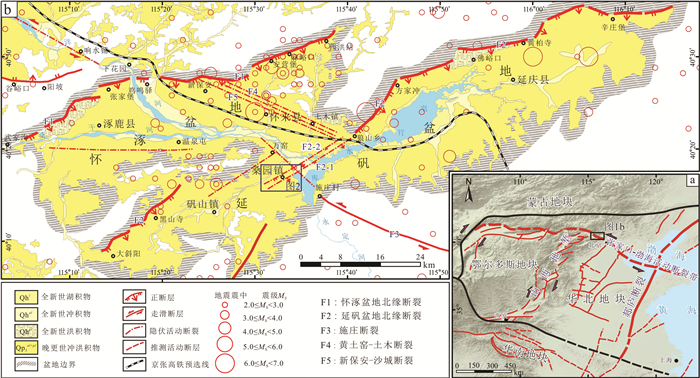
 下载:
下载:
